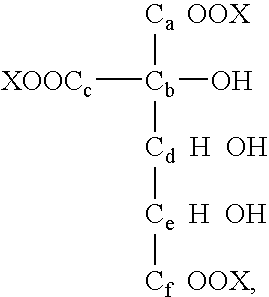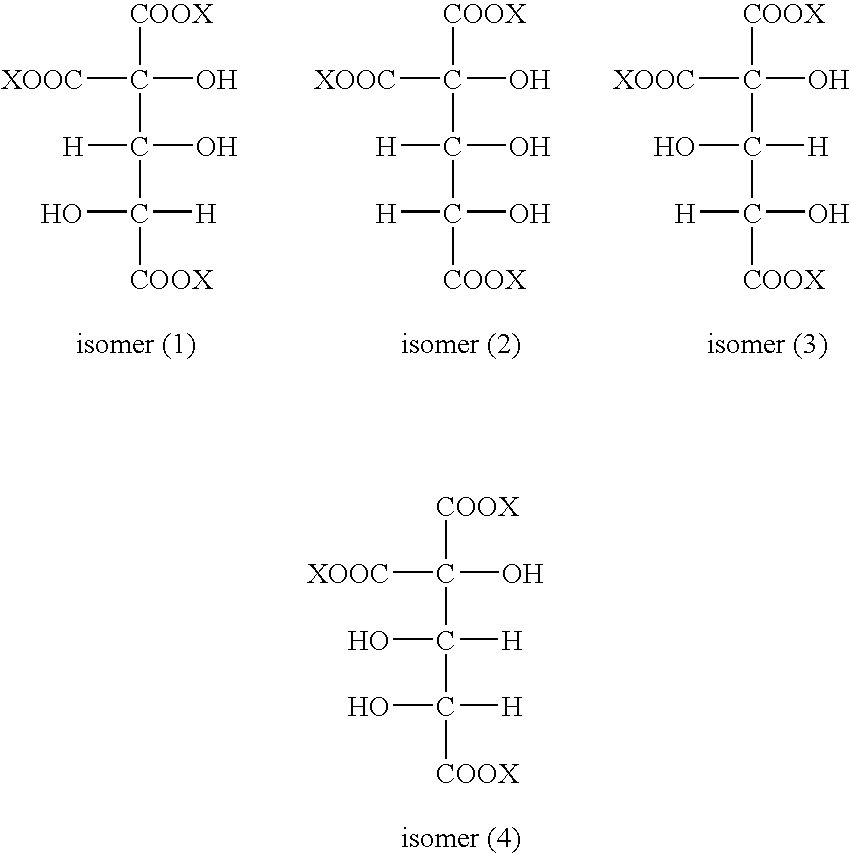Method for preparing a polycarboxylic composition comprising an electrochemical oxidation stage of a monosaccharide composition
- Summary
- Abstract
- Description
- Claims
- Application Information
AI Technical Summary
Benefits of technology
Problems solved by technology
Method used
Image
Examples
example 1
[0093]170 ml of osmosed water (2 Mohm.cm), 20 g (0.099 mol) of D-glucose in the form of dextrose monohydrate and 80 mg (0.51 mol) of “TEMPO” (2,2,6,6-tetramethyl-piperidinyloxy) are introduced into an electrolysis reactor connected to a system for controling pH and temperature and equipped with an anode composed of a carbon felt with a thickness of 5 mm and a specific surface of 0.3 m2 / g, supplied by Carbone-Corrbine, and with a cathode based on stainless steel.
[0094]Electrolysis is carried out at constant intensity (600 mA), the temperature of the reaction medium being maintained between 2 and 5° C. and the pH being regulated at 12.2 using a 4M potassium hydroxide solution. The electrolysis voltage (between anode and cathode) varies from 5V at the beginning of electrolysis to 3V at the end of the reaction. Electrolysis is halted when the amount of electricity delivered corresponds to 125% of the theoretical amount necessary for the oxidation of the glucose to glucaric acid (6 mol o...
example 2
[0131]Moreover, the Applicant Company tested the effectiveness of Composition 1A as detergency cobuilder in a compact powder formulation comprising 25% by weight of zeolites.
[0132]It was found that said Composition 1A could be used effectively here for its ability to reduce the precipitation of calcium and magnesium salts, this being the case both at 20° C. and at 40° C. or 60° C.
[0133]For this purpose, Composition 1A proved to be overall more effective, for example, than commercial synthetic complexing agents, such as sodium salts of iminodisuccinic acid (“IDS”) or ethylenediaminedi-succinic acid (“EDDS”).
[0134]In addition, it was observed that Composition 1A could, within the same compact detergent powder, be advantageously used in combination with other cobuilders, such as sodium tripolyphosphates or phosphonates. These combinations showed synergistic effects in terms of reduction in the precipitation of calcium and magnesium salts.
[0135]Furthermore, Composition 1A proved to be u...
example 3
[0136]The tests of Example 3 were carried out according to the general specifications of example 1 with a) an excess amount of current of 20% at 600 mA and an electrolysis time of 6 h 30 were used and b) the reaction pH was varied between 11 and 13.5 in increments of a pH unit of 0.5.
[0137]For each reaction pH studied, the levels, expressed as % (dry / dry) and as product in the acid form, of the following 4 products were measured:[0138]gluconic acid (hereinafter “Acid A”),[0139]glucaric acid (hereinafter “Acid B”),[0140]2-carboxy-2,3,4-trihydroxypentanedioic acid (herein-after “Acid C”),[0141]oxalic acid (hereinafter “Acid D”).
[0142]The results below were obtained, the figures after the decimal point being rounded up to the higher percent for those at least equal to 0.50 and being rounded down to the lower percent for those below 0.50.
[0143]
pH Level (%)1111.51212.51313.5Acid A1363210Acid B576877767882Acid C232117181610Acid D421232
[0144]Another series of tests was carried out under th...
PUM
| Property | Measurement | Unit |
|---|---|---|
| Fraction | aaaaa | aaaaa |
| Fraction | aaaaa | aaaaa |
| Fraction | aaaaa | aaaaa |
Abstract
Description
Claims
Application Information
 Login to view more
Login to view more - R&D Engineer
- R&D Manager
- IP Professional
- Industry Leading Data Capabilities
- Powerful AI technology
- Patent DNA Extraction
Browse by: Latest US Patents, China's latest patents, Technical Efficacy Thesaurus, Application Domain, Technology Topic.
© 2024 PatSnap. All rights reserved.Legal|Privacy policy|Modern Slavery Act Transparency Statement|Sitemap


